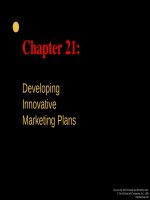Lecture biology (6e) chapter 21 campbell, reece
Bạn đang xem bản rút gọn của tài liệu. Xem và tải ngay bản đầy đủ của tài liệu tại đây (1.44 MB, 101 trang )
CHAPTER 21
THE GENETIC BASIS OF
DEVELOPMENT
Section A: From Single Cell to Multicellular Organism
1. Embryonic development involves cell division, cell differentiation, and
morphogenesis
2. Researchers study development in model organisms to identify general
principles
Copyright © 2002 Pearson Education, Inc., publishing as Benjamin Cummings
Introduction
ã TheapplicationofgeneticanalysisandDNA
technologytothestudyofdevelopmenthasbrought
aboutarevolutioninourunderstandingofhowa
complexmulticellularorganismdevelopsfroma
singlecell.
ã Forexample,in1995Swissresearchersdemonstratedthat
aparticulargenefunctionsasamasterswitchthattriggers
thedevelopmentoftheeyeinDrosophila.
ã Asimilargenetriggerseyedevelopmentinmammals.
ã Developmentalbiologistsarediscoveringremarkable
similaritiesinthemechanismsthatshapediverse
organisms.
Copyrightâ2002PearsonEducation,Inc.,publishingasBenjaminCummings
• While geneticists were advancing from Mendel’s
laws to an understanding of the molecular basis of
inheritance, developmental biologists were
focusing on embryology.
• Embryology is the study of the stages of development
leading from fertilized eggs to fully formed organism.
• In recent years, the concepts and tools of molecular
genetics have reached a point where a real
synthesis has been possible.
• The challenge is to relate the linear information in genes
to a process of development in four dimensions, three of
space and one of time.
Copyright © 2002 Pearson Education, Inc., publishing as Benjamin Cummings
• In the development of most multicellular organisms,
a singlecelled zygote gives rise to cells of many
different types.
• Each type has different structure and corresponding
function.
• Cells of similar types are organized into tissues,
tissues into organs, organs into organ systems, and
organ systems into the whole organism.
• Thus, the process of embryonic development must
give rise not only to cells of different types but to
higherlevel structures arranged in a particular way
in three dimensions.
Copyright © 2002 Pearson Education, Inc., publishing as Benjamin Cummings
1.Embryonicdevelopmentinvolvescell
division,celldifferentiation,and
morphogenesis
ã Anorganismarisesfromafertilizedeggcellasthe
resultofthreeinterrelatedprocesses:celldivision,
celldifferentiation,andmorphogenesis.
ã Fromzygotetohatchingtadpoletakesjustoneweek.
Fig.21.1
Copyrightâ2002PearsonEducation,Inc.,publishingasBenjaminCummings
• Cell division alone would produce only a great ball
of identical cells.
• During development, cells become specialized in
structure and function, undergoing differentiation.
• Different kinds of cells are organized into tissues
and organs.
• The physical processes of morphogenesis, the
“creation of form,” give an organism shape.
• Early events of morphogenesis lay out the basic
body plan very early in embryonic development.
• These include establishing the head of the animal embryo
or the roots of a plant embryo.
Copyright © 2002 Pearson Education, Inc., publishing as Benjamin Cummings
• The overall schemes of morphogenesis in animals
and plants are very different.
• In animals, but not in plants, movements of cells and
tissues are necessary to transform the embryo.
• In plants, morphogenesis and growth in overall size are
not limited to embryonic and juvenile periods.
Copyright © 2002 Pearson Education, Inc., publishing as Benjamin Cummings
Fig. 21.2
Copyright © 2002 Pearson Education, Inc., publishing as Benjamin Cummings
• Apical meristems, perpetually embryonic regions in
the tips of shoots and roots, are responsible for the
plant’s continual growth and formation of new
organs, such as leaves and roots.
• In animals, ongoing development in adults is
restricted to the differentiation of cells, such as
blood cells, that must be continually replenished.
• The importance of precise regulation of
morphogenesis is evident in human disorders that
result from morphogenesis gone awry.
• For example, cleft palate, in which the upper wall of the
mouth cavity fails to close completely, is a defect of
morphogenesis.
Copyright © 2002 Pearson Education, Inc., publishing as Benjamin Cummings
2.Researchersstudydevelopmentinmodel
organismstoidentifygeneralprinciples
ã Whentheprimaryresearchgoalistounderstand
broadbiologicalprinciplesưofanimalorplant
developmentinthiscaseưtheorganismchosenfor
studyiscalledamodelorganism.
ã Researchersselectmodelorganismsthatlendthemselves
tothestudyofaparticularquestion.
ã Forexample,frogswereearlymodelsforelucidatingthe
roleofcellmovementduringanimalmorphogenesis
becausetheirlargeeggsareeasytoobserveand
manipulate,andfertilizationanddevelopmentoccurs
outsidethemothersbody.
Copyrightâ2002PearsonEducation,Inc.,publishingasBenjaminCummings
• For developmental genetics, the criteria for
choosing a model organism include readily
observable embryos, short generation times,
relatively small genomes, and preexisting
knowledge about the organism and its genes.
• These include
Drosophila,
the nematode
C. elegans, the
mouse, the
zebrafish, and
the plant
Arabidopsis.
Fig. 21.3
Copyright © 2002 Pearson Education, Inc., publishing as Benjamin Cummings
• The fruit fly Drosophila melanogaster was first
chosen as a model organism by geneticist T.H.
Morgan and intensively studied by generations of
geneticists after him.
• The fruit fly is small and easily grown in the laboratory.
• It has a generation time of only two weeks and produces
many offspring.
• Embryos develop outside the mother’s body.
• In addition, there are vast amounts of information on its
genes and other aspects of its biology.
• However, because first rounds of mitosis occur without
cytokinesis, parts of its development are superficially
quite different from what is seen in other organisms.
Copyright © 2002 Pearson Education, Inc., publishing as Benjamin Cummings
• The nematode Caenorhabditis elegans normally
lives in the soil but is easily grown in petri dishes.
• Only a millimeter long, it has a simple, transparent body
with only a few cell types and grows from zygote to
mature adult in only three and a half days.
• Its genome has been sequenced.
• Because individuals are hermaphrodites, it is easy to
detect recessive mutations.
• Selffertilization of heterozygotes will produce some
homozygous recessive offspring with mutant
phenotypes.
Copyright © 2002 Pearson Education, Inc., publishing as Benjamin Cummings
• A further important feature is that every adult C.
elegans has exactly 959 somatic cells.
• These arise from the zygote in virtually the same way
for every individual.
• By following all cell divisions with a microscope,
biologists have constructed the organism’s complete cell
lineage, a type of fate map.
• A fate map traces the development of an embryo.
Copyright © 2002 Pearson Education, Inc., publishing as Benjamin Cummings
Fig. 21.4
Copyright © 2002 Pearson Education, Inc., publishing as Benjamin Cummings
• The mouse Mus musculus has a long history as a
mammalian model of development.
• Much is known about its biology, including its genes.
• Researchers are adept at manipulating mouse genes to
make transgenic mice and mice in which particular
genes are “knocked out” by mutation.
• But mice are complex animals with a genome as large
as ours, and their embryos develop in the mother’s
uterus, hidden from view.
Copyright © 2002 Pearson Education, Inc., publishing as Benjamin Cummings
• A second vertebrate model, the zebrafish Danio
rerio, has some unique advantages.
• These small fish (2 4 cm long) are easy to breed in the
laboratory in large numbers.
• The transparent embryos develop outside the mother’s
body.
• Although generation time is two to four months, the
early stages of development proceed quickly.
• By 24 hours after fertilization, most tissues and early
versions of the organs have formed.
• After two days, the fish hatches out of the egg case.
• The study of the zebrafish genome is an active area.
Copyright © 2002 Pearson Education, Inc., publishing as Benjamin Cummings
• For studying the molecular genetics of plant
development, researchers are focusing on a small
weed Arabidopsis thaliana (a member of the
mustard family).
• One plant can grow and produce thousands of progeny
after eight to ten weeks.
• A hermaphrodite, each flower makes ova and sperm.
• For gene manipulation research, scientists can induce
cultured cells to take up foreign DNA (genetic
transformation).
• Its relatively small genome, about 100 million
nucleotide pairs, has already been sequenced.
Copyright © 2002 Pearson Education, Inc., publishing as Benjamin Cummings
CHAPTER 21
THE GENETIC BASIS OF
DEVELOPMENT
Section B: Differential Gene Expression
1. Different types of cells in an organism have the same DNA
2. Different cell types make different proteins, usually as a result of
transcriptional regulation
3. Transcriptional regulation is directed by maternal molecules in the
cytoplasm and signals from other cells
Copyright © 2002 Pearson Education, Inc., publishing as Benjamin Cummings
Introduction
ã Thedifferencesbetweencellsinamulticellular
organismcomealmostentirelyfromdifferencesin
geneexpression,notdifferencesinthecells
genomes.
ã Thesedifferencesariseduringdevelopment,as
regulatorymechanismsturnspecificgenesoffand
on.
Copyrightâ2002PearsonEducation,Inc.,publishingasBenjaminCummings
1.Differenttypesofcellsinanorganism
havethesameDNA
ã Muchevidencesupportstheconclusionthatnearly
allthecellsofanorganismhavegenomic
equivalenceưưthatis,theyallhavethesamegenes.
ã Animportantquestionthatemergesiswhethergenes
areirreversiblyinactivatedduringdifferentiation.
Copyrightâ2002PearsonEducation,Inc.,publishingasBenjaminCummings
• One experimental approach to the question of
genomic equivalence is to try to generate a whole
organism from differentiated cells of a single type.
• In many plants, whole new organisms can develop
from differentiated somatic cells.
• During the 1950s, F.C. Steward and his students found
that differentiated root cells removed from the root
could grow into normal adult plants when placed in a
medium culture.
Copyright © 2002 Pearson Education, Inc., publishing as Benjamin Cummings
Fig. 21.5
Copyright © 2002 Pearson Education, Inc., publishing as Benjamin Cummings
• These cloning experiments produced genetically
identical individuals, popularly called clones.
• The fact that a mature plant cell can dedifferentiate
(reverse its function) and then give rise to all the
different kinds of specialized cells of a new plant
shows that differentiation does not necessarily
involve irreversible changes in the DNA.
• In plants, at least, cells can remain totipotent.
• They retain the zygote’s potential to form all parts of the
mature organism.
• Plant cloning is now used extensively in agriculture.
Copyright © 2002 Pearson Education, Inc., publishing as Benjamin Cummings
• Differentiated cells from animals often fail to
divide in culture, much less develop into a new
organism.
• Animal researchers have approached the genomic
equivalence question by replacing the nucleus of
an unfertilized egg or zygote with the nucleus of a
differentiated cell.
• The pioneering experiments in nuclear transplantation
were carried out by Robert Briggs and Thomas King in
the 1950s and extended later by John Gordon.
Copyright © 2002 Pearson Education, Inc., publishing as Benjamin Cummings









